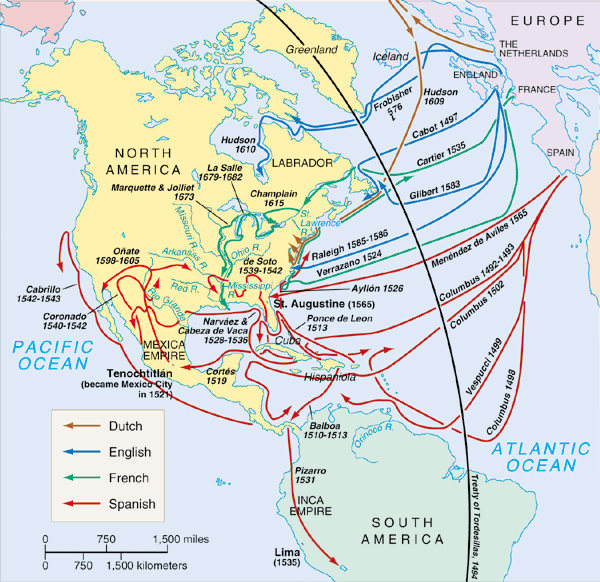England sent over two colonizing expeditions to America in 1607. One went to Jamestown and became the first permanent colony. The other, known as the Popham Colony, settled in Maine on the lower Kennebec. After a rugged winter and the death of a leader, the Popham colonists went back to England. (Albion)
The Puritans who founded New England had come not to amass wealth by trade or by planting a fertile land, but to attempt a religious and civil experiment in government. On this barren shore along the coast they desired to worship in their own religious faith and be free from unsympathetic outsiders.
They hoped also to make their own laws without interference from the English Crown. The founding of this strong colony in a strategic military position formed a bulwark against the French and their Indian allies from the north, and against the threat from the Dutch in New York.
This strip of land, hemmed in by the foothills of the mountains, was bordered by the sea which, like a stern but friendly jailer, offered a means to enlarge the too scanty production of their land and promised tempting rewards to those who escaped the perils of storms, privateers and pirates and evaded the enforcement of intolerable navigation laws. (Gleason, Old Ships and Ship-building Days of Medford)
Shipbuilding in America dates back to 1607, when the Virginia was built at the mouth of the Kennebec River. It was the Popham group which built the Virginia.
The colonists had come over in two small vessels. One of the well-connected captains was George Popham, nephew of the Lord Chief Justice; the other was Ralph Gilbert, a son of the late Humphrey Gilbert. They set to work at once in building a storehouse, fort, and other buildings, as well as the Virginia.
Investigations indicate the following possible dimensions: length over all, 51 feet 6 inches; length of keel, 38 feet 6 inches; maximum breadth inside the planking, 13 feet; depth for tonnage, 5 feet.
The Popham colonist were well aware of the vessel characteristics necessary for successful trading operations on the coast and rivers of New England. The Virginia apparently accompanied the discouraged colonists when they decided to return to England. (Albion)
Appreciating the advantages to be derived from the encouragement of shipbuilding in New England, managers of the Massachusetts Bay Company in London, in their first recorded letter, dated April 17, 1629, stated that six shipwrights had been sent to New England, of which Robert Moulton was the chief.
The first vessel built in Massachusetts Bay Colony was the bark Blessings of the Bay, 30 tons, owned by Governor Winthrop. She was launched into the Mystic River at Medford, July 4, 1631. (Old Scituate, Daughters of the American Revolution)
Governor Winthrop, in the year after his arrival, had built in Medford, opposite his estate at Ten Hills, the Blessing of the Bay (about the size of the Virginia and forerunner of much further building), a bark of thirty tons. On August 9, 1631, the governor’s bark went to sea.
It cost one hundred and forty-five pounds. The owner said of it on May 16, 1636, “I will sell her for one hundred and sixty pounds.”
These vessels were employed in the coasting or fishing trade, and it was not until 1640 that vessels for the transatlantic trade were launched in the Colonies.
Shipbuilding, on an extended scale, was carried on during the Revolutionary War both by the Government and by private individuals. The great abundance of oak growing near the Merrimac River made that a favored locality for shipbuilding, and as early as 1650 Newbury, Salisbury, and Haverhill were actively engaged in the work.
Click the following link to a general summary about the Blessings of the Bay:
https://imagesofoldhawaii.com/wp-content/uploads/Blessings-of-the-Bay.pdf
















